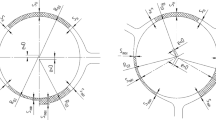Conclusions
In developing designs of refractory-producing mills, one must try to achieve the smallest roller diameter and roller weight corresponding to the specified pressure and width of the roller on the mixture. An equation is given for determining the optimum diameter and weight of the rollers.
Similar content being viewed by others
Literature cited
A. K. Karklit, A. P. Larin, V. E. Vernikovskii, et al., The Production of Refractories by the Semidry Method [in Russian], Metallurgiya, Moscow (1972).
M. Ya. Sapozhnikov and I. A. Bulavin, Machines and Equipment for the Silicate Industry [in Russian], Promstroiizdat, Moscow (1950).
Ya. M. Pikovskii, Road Machines and Equipment [in Russian], Mashgiz, Moscow (1960).
Author information
Authors and Affiliations
Additional information
Translated from Ogneupory, No. 5, pp. 24–25, May, 1982.
Rights and permissions
About this article
Cite this article
Larin, A.P. Determining the dimensions of mixing mill rollers. Refractories 23, 233–234 (1982). https://doi.org/10.1007/BF01387347
Issue Date:
DOI: https://doi.org/10.1007/BF01387347




